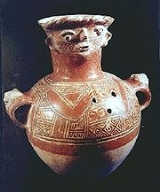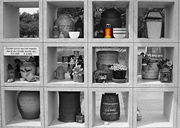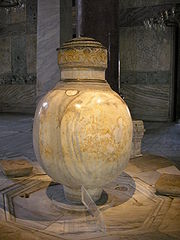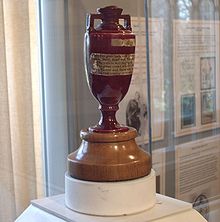
Urn
Encyclopedia



Vase
The vase is an open container, often used to hold cut flowers. It can be made from a number of materials including ceramics and glass. The vase is often decorated and thus used to extend the beauty of its contents....
, ordinarily covered, that usually has a narrowed neck above a footed pedestal
Pedestal
Pedestal is a term generally applied to the support of a statue or a vase....
. "Knife urns" placed on pedestals flanking a dining-room sideboard
Sideboard
A sideboard is an item of furniture traditionally used in the dining room for serving food, for displaying serving dishes such as silver, and for storage. It usually consists of a set of cabinets, or cupboards, and one or more drawers, all topped by a flat display surface for conveniently holding...
were an English innovation for high-style dining room
Dining room
A dining room is a room for consuming food. In modern times it is usually adjacent to the kitchen for convenience in serving, although in medieval times it was often on an entirely different floor level...
s of the late 1760s. They went out of fashion in the following decade, in favour of knife boxes that were placed on the sideboard.
In Classical terms, an urn is a large decorative covered container of wood, metal, pottery, etc. In furniture, it was a large wooden vase-like container which was usually set on a pedestal on either side of a side table. This was the characteristic of Adam
Adam style
The Adam style is an 18th century neoclassical style of interior design and architecture, as practiced by the three Adam brothers from Scotland; of whom Robert Adam and James Adam were the most widely known.The Adam brothers were the first to advocate an integrated style for architecture and...
designs and also of Hepplewhite
George Hepplewhite
George Hepplewhite was a cabinetmaker. He is regarded as having been one of the "big three" English furniture makers of the 18th century, along with Thomas Sheraton and Thomas Chippendale...
's work. Urns were also used as decorative turnings at the cross points of stretchers in 16th and 17th century furniture designs. The urn and the vase were often set on the central pedestal in a "broken" or "swan's" neck pediment.
Cremation urns
Funerary urns (also called cinerary urns and burial urns) were used by many civilizations. After a person died, survivors cremated the body and collected the ashes in an urn (see also lekythosLekythos
A lekythos is a type of Greek pottery used for storing oil , especially olive oil. It has a narrow body and one handle attached to the neck of the vessel. The lekythos was used for anointing dead bodies of unmarried men and many lekythoi are found in tombs. The images on lekythoi were often...
, a type of pottery in ancient Greece
Pottery of Ancient Greece
As the result of its relative durability, pottery is a large part of the archaeological record of Ancient Greece, and because there is so much of it it has exerted a disproportionately large influence on our understanding of Greek society...
used for holding oil in funerary ritual). In the Bavaria
Bavaria
Bavaria, formally the Free State of Bavaria is a state of Germany, located in the southeast of Germany. With an area of , it is the largest state by area, forming almost 20% of the total land area of Germany...
n tradition, a king's heart would be placed in the urn upon his death (as happened with King Otto of Bavaria
Otto of Bavaria
Otto , was King of Bavaria from 1886 to 1913. He was the son of Maximilian II and his wife, Marie of Prussia, and younger brother of Ludwig II...
in 1916). Cremation urns were also commonly used in Anglo Saxon England
England
England is a country that is part of the United Kingdom. It shares land borders with Scotland to the north and Wales to the west; the Irish Sea is to the north west, the Celtic Sea to the south west, with the North Sea to the east and the English Channel to the south separating it from continental...
.
Romans
Ancient Rome
Ancient Rome was a thriving civilization that grew on the Italian Peninsula as early as the 8th century BC. Located along the Mediterranean Sea and centered on the city of Rome, it expanded to one of the largest empires in the ancient world....
placed the urns in a niche in a collective tomb
Tomb
A tomb is a repository for the remains of the dead. It is generally any structurally enclosed interment space or burial chamber, of varying sizes...
called a columbarium
Columbarium
A columbarium is a place for the respectful and usually public storage of cinerary urns . The term comes from the Latin columba and originally referred to compartmentalized housing for doves and pigeons .The Columbarium of Pomponius Hylas is a particularly fine ancient Roman example, rich in...
(literally, dovecote
Dovecote
A dovecote or dovecot is a structure intended to house pigeons or doves. Dovecotes may be square or circular free-standing structures or built into the end of a house or barn. They generally contain pigeonholes for the birds to nest. Pigeons and doves were an important food source historically in...
). The interior of a dovecote usually has niches to house doves
Doves
Doves are an English alternative indie rock band, originating from Wilmslow, Cheshire. The band comprises brothers Jez Williams and Andy Williams , and Jimi Goodwin . The members started working seriously together after meeting at The Haçienda in Manchester. Doves' unofficial fourth member is...
.
The discovery of a Bronze Age
Bronze Age
The Bronze Age is a period characterized by the use of copper and its alloy bronze as the chief hard materials in the manufacture of some implements and weapons. Chronologically, it stands between the Stone Age and Iron Age...
urn burial in Norfolk, England prompted Sir Thomas Browne
Thomas Browne
Sir Thomas Browne was an English author of varied works which reveal his wide learning in diverse fields including medicine, religion, science and the esoteric....
to carefully describe the antiquities found. He expanded his study to survey burial and funerary customs, ancient and current, and published it as Hydriotaphia or Urn Burial
Hydriotaphia, Urn Burial
Hydriotaphia, Urn Burial, or a Discourse of the Sepulchral Urns lately found in Norfolk, is a work by Sir Thomas Browne, published in 1658 as the first part of a two-part work that concludes with The Garden of Cyrus....
(1658).
Other urns

The Ashes
The Ashes is a Test cricket series played between England and Australia. It is one of the most celebrated rivalries in international cricket and dates back to 1882. It is currently played biennially, alternately in the United Kingdom and Australia. Cricket being a summer sport, and the venues...
, the prize in the biennial Test cricket
Test cricket
Test cricket is the longest form of the sport of cricket. Test matches are played between national representative teams with "Test status", as determined by the International Cricket Council , with four innings played between two teams of 11 players over a period of up to a maximum five days...
competition between England
English cricket team
The England and Wales cricket team is a cricket team which represents England and Wales. Until 1992 it also represented Scotland. Since 1 January 1997 it has been governed by the England and Wales Cricket Board , having been previously governed by Marylebone Cricket Club from 1903 until the end...
and Australia
Australian cricket team
The Australian cricket team is the national cricket team of Australia. It is the joint oldest team in Test cricket, having played in the first Test match in 1877...
, are contained in a miniature urn.
Urns are a common form of architectural detail
Architecture
Architecture is both the process and product of planning, designing and construction. Architectural works, in the material form of buildings, are often perceived as cultural and political symbols and as works of art...
and garden ornament
Garden ornament
A Garden ornament is an item used for garden, landscape, and park enhancement and decoration.The category can include:*bird baths,**bird feeders,**nest box-bird houses*columns - cast stone*fountains,**rocks and boulders with basins...
. Well-known ornamental urns include the Waterloo Vase
Waterloo Vase
The Waterloo Vase is a great urn, 15ft high and weighing 20 tons, fashioned from a single piece of Carrara marble. Since 1906, it has been used as a garden ornament in the garden of Buckingham Palace, London....
.
In mathematics, an urn problem
Urn problem
In probability and statistics, an urn problem is an idealized mental exercise in which some objects of real interest are represented as colored balls in an urn or other container....
is a thought experiment
Thought experiment
A thought experiment or Gedankenexperiment considers some hypothesis, theory, or principle for the purpose of thinking through its consequences...
in probability theory
Probability theory
Probability theory is the branch of mathematics concerned with analysis of random phenomena. The central objects of probability theory are random variables, stochastic processes, and events: mathematical abstractions of non-deterministic events or measured quantities that may either be single...
.
A tea urn is a heated metal container traditionally used to brew tea or boil water in large quantities in factories, canteens or churches. They are not usually found in domestic use. Like a samovar
Samovar
A samovar is a heated metal container traditionally used to heat and boil water in and around Russia, as well as in other Central, South-Eastern, Eastern European countries,Kashmir and in the Middle-East...
it has a small tap near the base for extracting either tea or hot water. Unlike an electric water boiler
Electric water boiler
An electric water boiler, also called an electric dispensing pot, electric water heater, electric water urn, is a consumer electronics small appliance used for boiling water and maintaining it at a constant temperature...
, tea may be brewed in the vessel itself, although they are equally likely to be used to fill a large teapot
Teapot
A teapot is a vessel used for steeping tea leaves or a herbal mix in near-boiling water. Tea may be either in a tea bag or loose, in which case a tea strainer will be needed, either to hold the leaves as they steep or to catch the leaves inside the teapot when the tea is poured...
.
External links
- Daily Mail article on a Roman cinerary urn
- Cremation urn examples
- More Cremation Urns Examples
- Wood Cremation Urns Examples
- Getty. Art & Architecture Thesaurus. Urns

